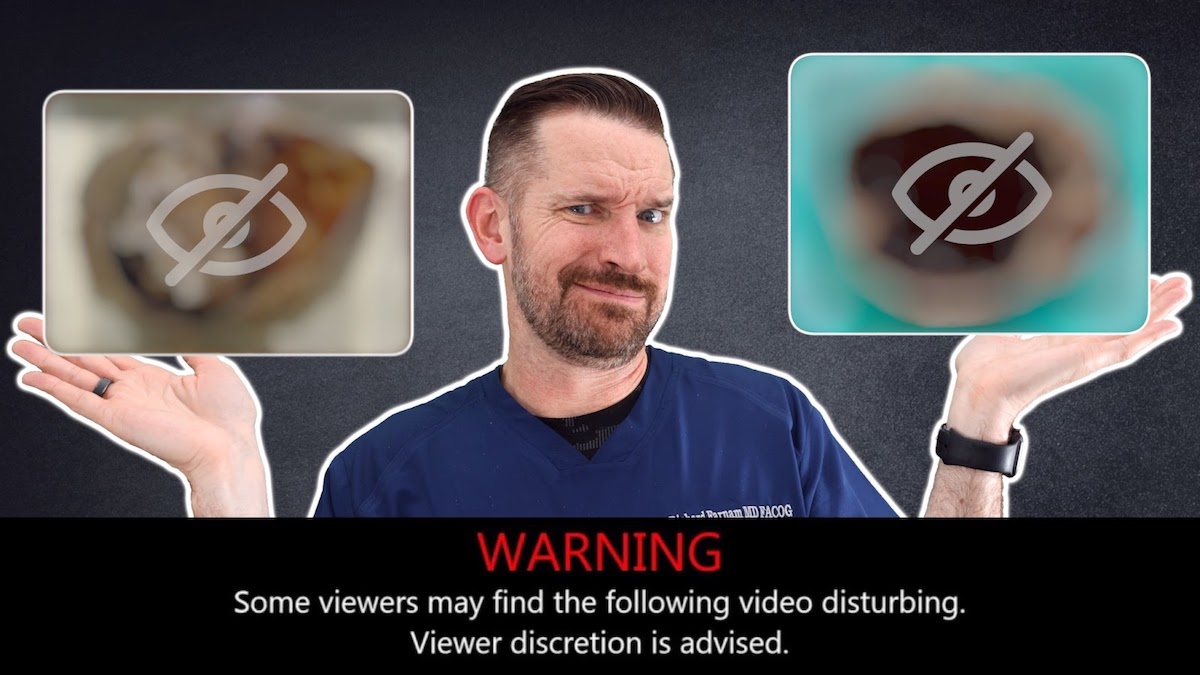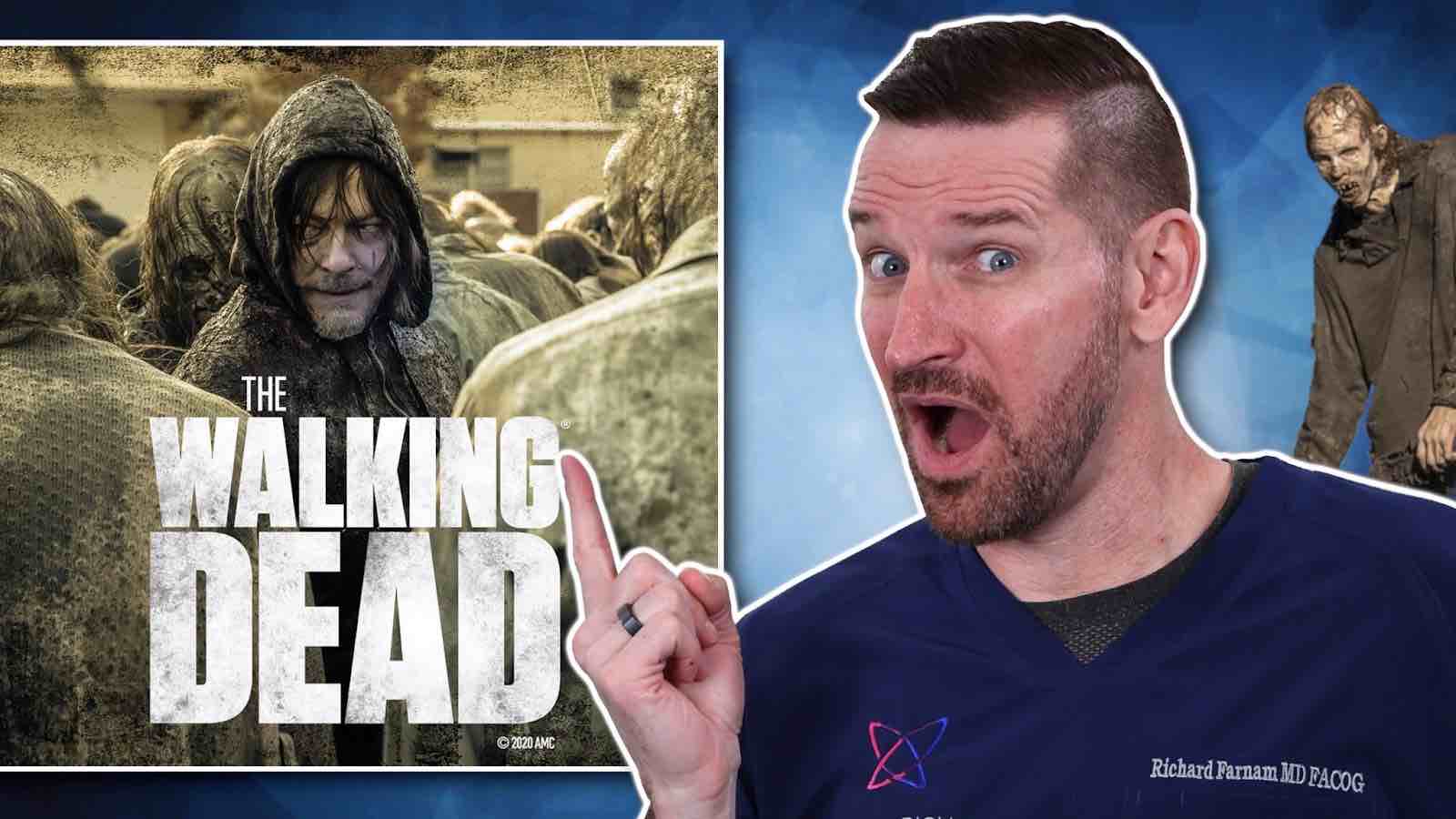Doctor Rich:
So a day in the life of an OB/GYN. It’s 5:30. This is when the day starts before anybody else gets up. Alright — let’s go get this day!
Don’t have time to read this post? Watch the video here instead!
First thing we’ve got to do is get five minutes of exercise — to get the blood flowing.
Okay, so I’ve got a series of rituals or habits that help me set my attention for the day and get the most out of every day. Here we go. So you’ve probably heard the adage, “happy wife, happy life.“ So every morning, I just write my daily love note [places a sticky note on the mirror]. So we’ll just add this one to the collection here.
Walking to the kitchen here… [dog walks up to say “Good morning”] Oh! Say hi to Luna.
[camera pans to kids sleeping on the couches] Looks like the triplets had a sleepover last night on the couch. They’re not supposed to do that on a weekday…
[brewing some coffee]
All right, just got to start the morning right here.
[sitting at the table with some sliced lemons and glass of water]
Do you ever feel tired? Joint pains, headache? Well, it’s probably because you’re dehydrated — and you’re most dehydrated first thing in the morning. Try to drink three or four liters of water a day. We’re gonna drop a little bit of lemon in there — the citrate helps gut absorption of E minerals. [pouring some vitamins into a small glass] Going to get some 369-blend of omega acids — just to kind of get our healthy balance going — and some lemon in there as well. I’m also going to grab a couple of vitamin D and some magnesium.
And with that, we’re off to work! [Doctor Rich’s daughter runs up to give him a hug] Okay, that’s my little one 🙂
[Driving]
So we’re off bright and early before the crack of dawn. The key is to be efficient in the OR. We want to serve as many patients as we can — in the amount of time we can. ORs assign block time — which means it’s time for you to put your surgeries on and nobody else can put their surgeries at that time. BUT you have to put surgeries on during those blocks or they may reallocate that time.
So it’s “A day in the life of an OB/GYN.” There’s OB and there’s GYN. I don’t practice obstetrics. I’m a subspecialist for urogynecology — which is a surgical subspecialty of gynecology that basically deals with prolapse, incontinence, pelvic pain… But I try to do surgery every single morning to just get the most efficient use of my day.
[stopped at a red light while driving]
Wow. This light seems to be broken here. The drive to my main hospital from my house is about ten minutes. My other hospital is about 18 minutes away. So a kind of nice thing about getting up early is you don’t have to deal with traffic — because you’re getting there before everybody else.
So I would call myself an “accidental morning person.” I don’t jump out of bed, you know, excited to get the day. But as it turns out — it actually is the most efficient use of your day.
[arriving at the hospital]
And we’re here.
[inside wearing scrubs and looking at a chart]
All right. So it is 6:45am — we are on time. I’m going to go pre-op the patient, and then we’ll see you in the back.
[to someone behind a divider curtain]
Good morning!
[at the sink, washing his hands]
All right. So every morning, we’ve got to scrub in and get ready for the case. And here we go…
[in the OR in front of the surgical robot]
So you asked me to explain “What is this robot thing?” Well, traditionally we’ve had open surgery. We have a scalpel and instruments, and we use these to make an incision on the abdominal wall. We can get our hands inside the actual abdominal cavity and do whatever surgery that we need to do. The problem is that it creates a big scar that’s not cosmetically appealing — and the recovery’s much longer (three to four times as long)! So then we came up with the idea of doing laparoscopic surgery. We created these long instruments that go through little keyhole incisions on the abdominal wall. And instead of having our hands inside the patient, we could do the surgery with these little tiny instruments. Then we have robotic surgery. In robotic surgery, we basically take these laparoscopic instruments and we attach them to the robot and we sit at a console. And our movements that we make over here are translated to the robot over here — like such.
[driving to clinic]
All right, so after we finish up doing a case (sometimes two cases in the OR), we’ll head over to clinic. And one of the super cool things is — in many cases — I’m able to offer the patient a minimally invasive solution (or a surgery with small incisions) with the robot — that frankly, some of their other medical opinions told them they couldn’t have (for one reason or another).
Maybe they told them their fibroids were too big or they had too much abdominal surgery or they had maybe too many C-sections. One of the benefits of having served so many patients over so many years (and having done over 3,000 surgeries) is that we’ve got a pretty good system for being able to perform the surgery in a minimally invasive way with the robot (as opposed to having to do an open incision). A standard clinic day — if I’m doing a full day — starts around 8:30, we take our last patient in at about 3:30, and finish charting sometime around maybe 5:30. And on some days, I get to finish up early and (if I get done early enough), I get to pick up the kids from school — which is always a highlight!
I’ve got about ten minutes until we have our morning meeting where we will kind of go over the agenda for the day. Then it’s basically an all-out sprint for the next eight hours.
As any doctor will tell you — charting is kind of the bane of their professional existence. Sometimes it can take hours after clinic — and while you are there in the office, you want to BE there for your patient. You don’t want to sit there and type and not pay any attention! You want to be present, and it’s hard to be empathetic when you’re staring down a computer screen. And I think (well, I KNOW) that patients appreciate that. Some of the critical elements of the interview have to be chronicled in the moment — but… Oh, it’s a challenge. It’s a challenge to have to go back and input all that data later. I know they’re working on systems of artificial intelligence, where you have an Alexa that you just put right between you and the patient and you talk, and the patient responds and the robot brain (through deep thought and machine learning) creates the entire note for you. So it’s not just robots in the OR, there are going to be robots everywhere that will be helpful in medicine — and every other industry.
So this is the office building — it’s quite beautiful.
[in the clinic, wearing scrubs]
All right, guys. Ready for clinic! Let’s do this. All right, so this is our lovely office where we get things done and provide world-class patient care. All right!
Staff:
Hi, Dr. Farnam!
Doctor Rich:
Good morning! Here’s my team — they’re the world’s best team. Are we gonna have a good day today?
Staff:
We’re going to have a great day!
Doctor Rich:
Awesome. [walking down the hall] These are all the exam rooms. This is where we identify what needs to be fixed or helped and how we can best help patients. Sometimes it’s just an office visit, sometimes that means going to the operating room to get a permanent resolution.
Come on over! [to his staff] Dolores… Good morning!
Doctor Rich:
Say hi!
Dolores:
Good morning!
Doctor Rich:
We going to have a good day today?
Dolores:
Always!
Doctor Rich:
Only sixty patients on the schedule? [laughing] All right!
Staff:
We got you, Doctor!
Doctor Rich:
Oh, I appreciate it. All right, thanks! Let’s make it a great day!
[time-lapse video of Doctor Rich in his office]
[sitting at his desk]
All right. And now for every physician’s least favorite part of clinical work — charting. So we’re going to sit here and document. We have our handy dictaphone here… [mumbling indistinctly] All right — let’s see what we got. [the computer screen shows typed gibberish] Oh, geez, that’s no good! Let me see… [Doctor Rich taps on the screen, and the words “magically” change from gibberish to actual notes on a patient] Oh, okay. Yeah. Much better.
[clock on the screen reads 6:00pm. Doctor Rich walks in the door to his house]
Doctor Rich:
Hey guys, I’m home…
[kids run up and hug their dad, and Luna the dog comes to say “hello” as well]
[walking out the door with the dog on a leash]
All right. Now it’s time to take Luna for a walk.




